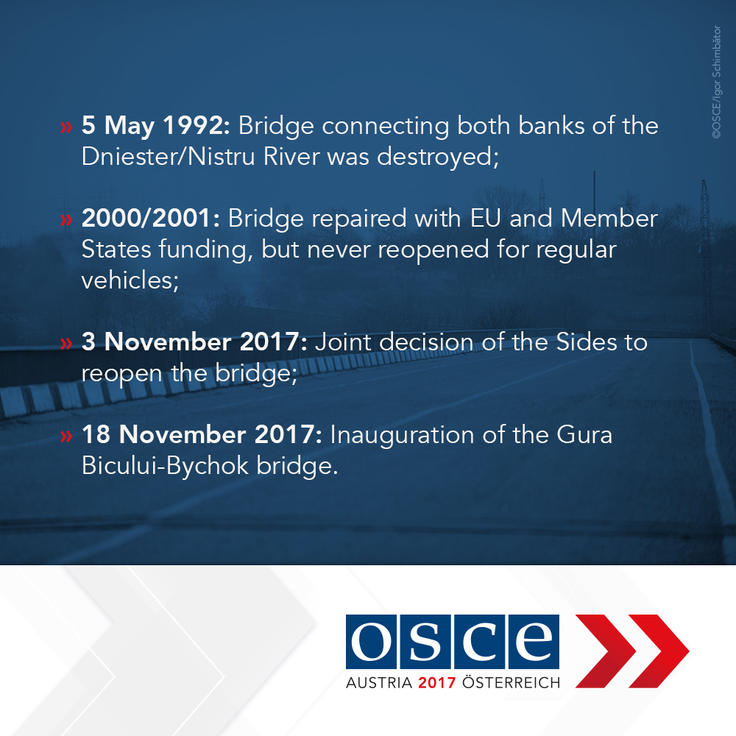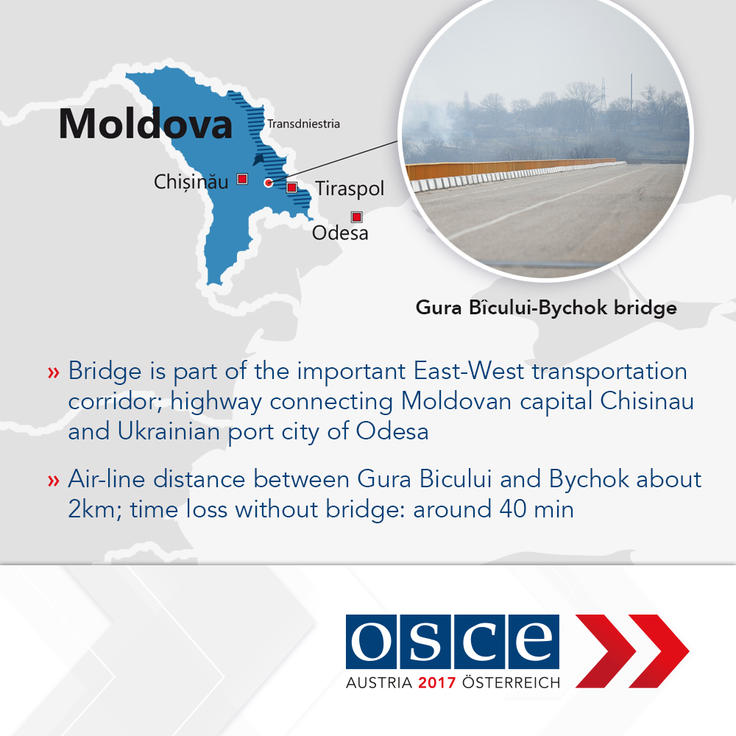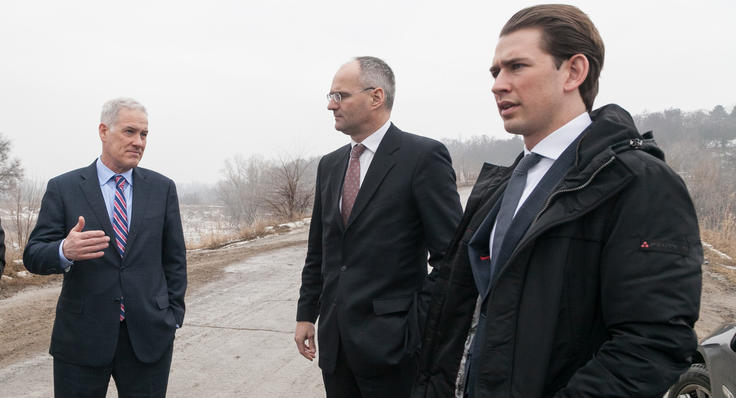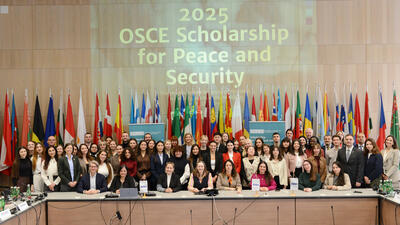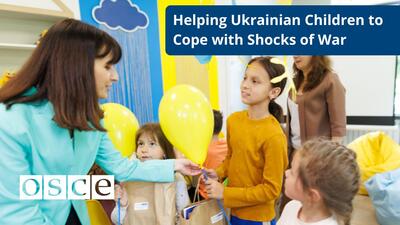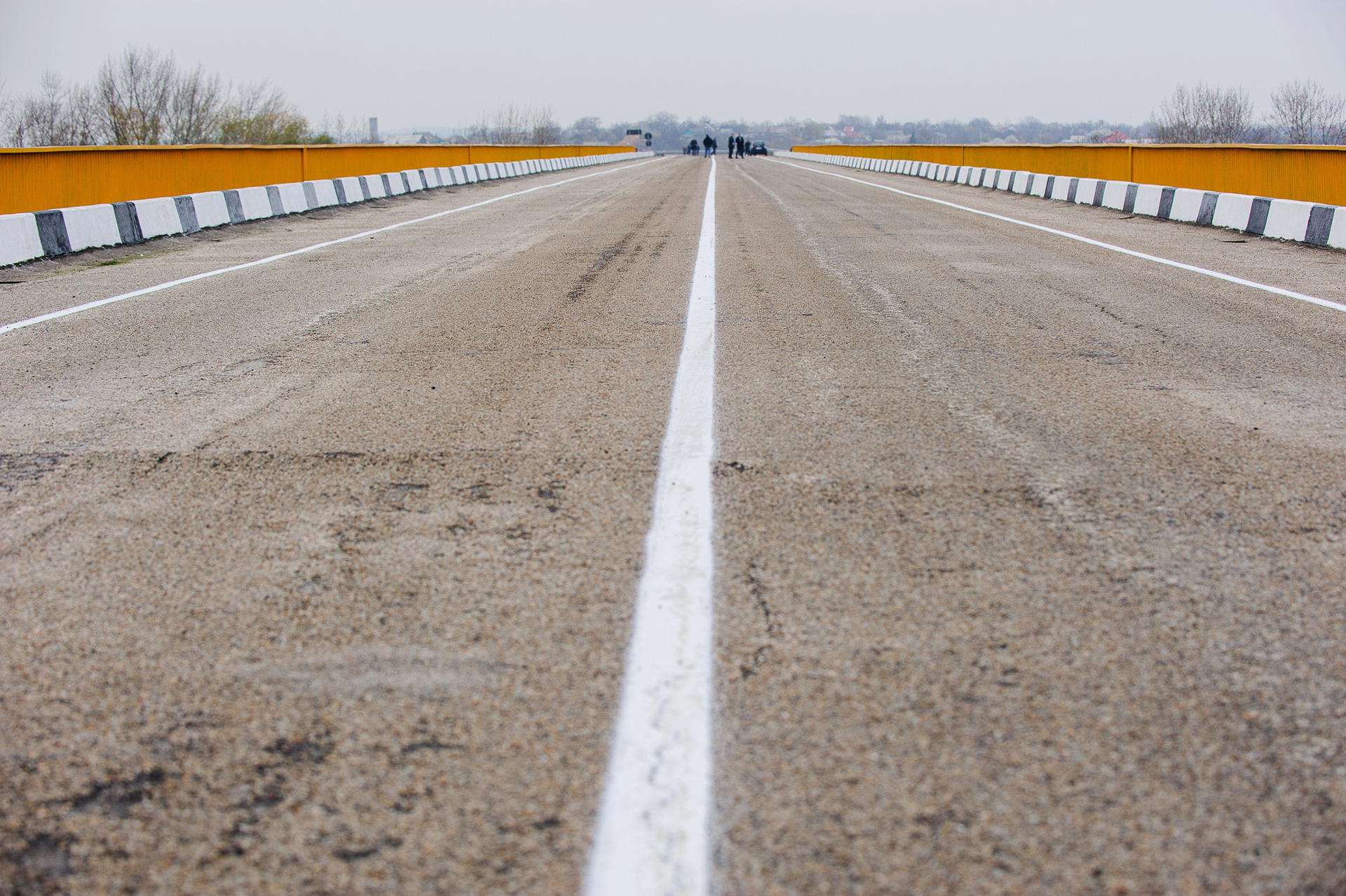
Story
Austrian OSCE Chairmanship on Transdniestria: Meaningful dialogue to produce tangible results
- Date:
- Source:
- OSCE Mission to Moldova
- Fields of work:
- Conflict prevention and resolution
The OSCE chairs the negotiations between Moldova and Transdniestria towards a comprehensive, peaceful and sustainable settlement of the Transdniestrian conflict. Since 2005, this process has been known as the “5+2" process. It includes the OSCE, Russia and Ukraine as mediators, and the European Union and the United States as observers.
Led by the Special Representative of the OSCE Chairperson-in-Office for the Transdniestrian Settlement Process and the Head of the OSCE Mission to Moldova, the OSCE facilitates dialogue between Chisinau and Tiraspol and works with the sides to build confidence between people living on both banks of the Dniester/Nistru river.
The Sides signed a ground-breaking decision on 3 November 2017 to reopen the Gura Bicului-Bychok bridge, which connects both banks of the Dniester/Nistru River and has not been in operation since the 1992 conflict.
“This is good news for the local population and businesses on both sides of the river,” said Ambassador Wolf Dietrich Heim, the Special Representative of the OSCE Chairperson-in-Office for the Transdniestrian Settlement Process. “It opens a crucial civilian transportation artery, improves connectivity, can enhance trade, and helps to build confidence between the Sides.”
Head of the OSCE Mission to Moldova Ambassador Michael Scanlan, called the agreement to reopen the bridge “an historic day” and expressed confidence that additional agreements would be reached in the next few months. Read the full press release here.
The bridge was reopened on 18 November 2017.
Results-oriented dialogue
Since assuming the post under Austria's 2017 OSCE Chiarmanship, Ambassador Heim has consistently reaffirmed a key message of the Hamburg Ministerial Statement of December 2016: the importance of constructive, results-oriented dialogue for achieving concrete results and creating the conditions for holding an output-based meeting in the 5+2 format. The Hamburg Ministerial Statement was adopted by all 57 OSCE participating States – including Moldova and representatives of the 5+2 mediators and observers.
What is the 5+2 format?
Talks in the 5+2 format include the representatives of the sides, mediators and observers – Moldova, Transdniestria, the OSCE, the Russian Federation, Ukraine, the United States and the European Union. The goal of the 5+2 format is to work out the parameters of the comprehensive settlement based on the sovereignty and territorial integrity of the Republic of Moldova within its internationally recognized borders, with a special status for Transdniestria, as reconfirmed by all 57 OSCE participating States in the Ministerial Council Statement agreed in Hamburg on 9 December 2016.
Visits to the region
In his first visit to the Republic of Moldova as Special Representative on 20 January, Ambassador Heim built on the German OSCE Chairmanship’s efforts to assist the sides in engaging in substantive, result-oriented dialogue. He recalled that the international 5+2 partners had guided this output-based approach, which was endorsed by all 57 OSCE participating States in the OSCE Ministerial Statement of December 2016.
“This approach will strengthen mutual confidence, advance the settlement process and improve the lives of people on both banks of the Dniester/Nistru River,” underscored Heim. Read more here.
On 3 and 4 February, Heim accompanied the OSCE Chairperson-in-Office and Austrian Foreign Minister Sebastian Kurz on a visit to Chisinau and Tiraspol. Just four weeks into the Austrian OSCE Chairmanship, this high-level visit reflected the importance the Austrian Chairmanship attaches to making progress in the settlement process. Kurz reminded Moldova’s government of its commitment to develop a government policy and vision for a special status for Transdniestria.
In line with successive OSCE Ministerial Council statements and the joint position of the OSCE “Troika”, the Chairperson-in-Office noted that the conflict’s resolution “must clearly be the territorial integrity and sovereignty of Moldova combined with a special status for Transdniestria.” Read more of his statement here.
What is the OSCE “Troika”?
Each year, a different OSCE participating State chairs the Organization. The OSCE Troika is a format of co-operation between the present, previous and succeeding Chairmanships. Through extensive dialogue and consultations between the Chairmanships, the Troika system ensures continuity and consistency in the OSCE’s leadership and policy. This policy coherence is reflected in the position of the current Austrian OSCE Chairmanship on the Transdniestrian settlement process, which has maintained the stance of the 2016 German Chairmanship on the importance of substantive, output-based dialogue.
Following up on the OSCE Chairperson’s visit in February, Ambassador Heim visited Chisinau and Tiraspol from 22 to 24 March and urged the sides to focus on maintaining constructive, results-oriented dialogue at the 1+1 and working group levels in order to finalize agreements on the ‘package of eight’ issues that they had defined as their priorities. These include the four outstanding agreements on education, transport, communications and law enforcement contained in the Berlin Protocol, signed by the sides in June 2016, plus issues regarding the Moldovan-administered Latin-script schools in Transdniestria, access to the Dubasari farmland, freedom of movement for people, goods and services, and the reopening of the Gura Bicului-Bychok bridge.
“Now is the time for the sides to take ownership of the commitments already made and to follow these through,” said Heim. Read more here.
‘Political courage’
During his fourth visit to Chisinau and Tiraspol from 24 to 25 May, Heim brought the Moldovan and Transdniestrian chief negotiators together for their first meeting since 14 March to discuss what actions they are ready to take to reach agreements on the package of eight issues. Heim underscored that achieving progress on any of these issues would create the conditions for holding talks in the 5+2 format. Read more of his statement here.
He noticed positive sentiment for progress during his fifth visit to the region from 7 to 8 September.
“The political will expressed at my meetings in Chisinau and Tiraspol gives me hope that the Sides are ready to undertake measures to unlock the benefits of some aspects of the package of eight that they themselves have defined as their priorities,” Heim said. “We value the voiced political will and encourage the Sides to follow through on it, thus giving an impetus to the negotiations at all levels of the settlement process and helping to achieve progress for the benefit of people on both banks of the Dniester/Nistru.” Read more here.

